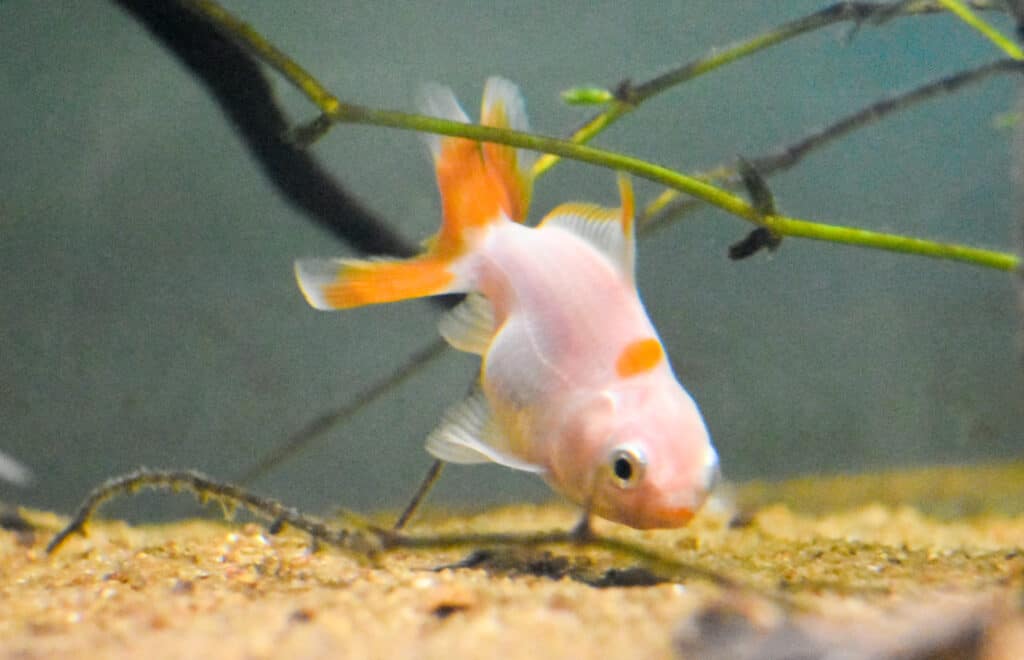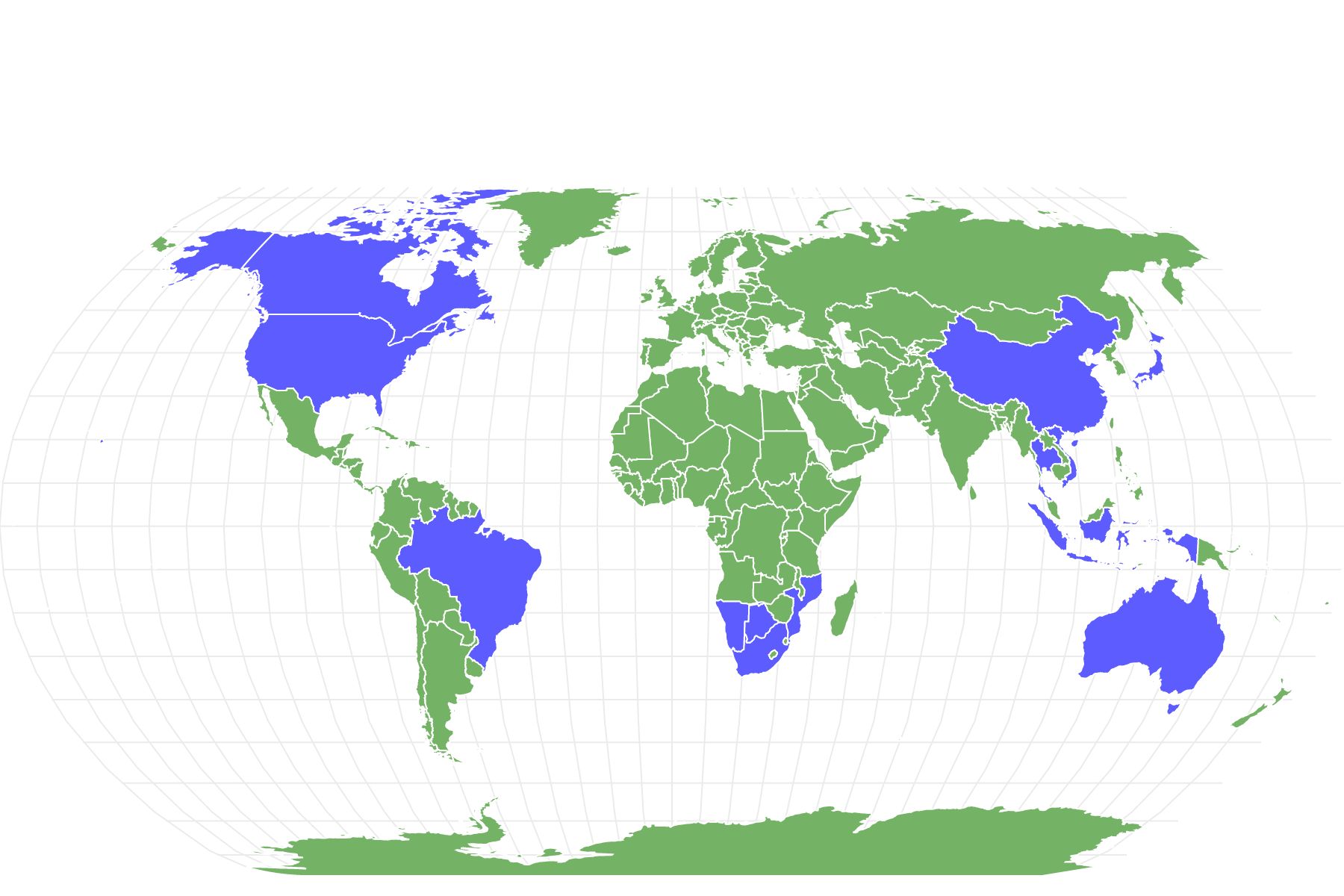Oranda Goldfish
Carassius auratus auratus
Oranda goldfish are one of the most popular fancy goldfish breeds
Advertisement
Oranda Goldfish Scientific Classification
- Kingdom
- Animalia
- Phylum
- Chordata
- Class
- Actinopterygii
- Order
- Cypriniformes
- Family
- Cyprinidae
- Genus
- Carrassius
- Scientific Name
- Carassius auratus auratus
Read our Complete Guide to Classification of Animals.
Oranda Goldfish Conservation Status
Oranda Goldfish Facts
- Prey
- Worms and small crustaceans
- Name Of Young
- Fry
- Group Behavior
- Social
- Fun Fact
- Oranda goldfish are one of the most popular fancy goldfish breeds
- Most Distinctive Feature
- Jelly-like growth on their head known as a wen
- Other Name(s)
- Dutch lionhead
- Temperament
- Friendly
- Optimum pH Level
- 6.0-8.0
- Average Spawn Size
- 1,000 eggs
- Habitat
- Aquariums and ponds
- Diet
- Omnivore
- Lifestyle
- Crepuscular
- Favorite Food
- Sinking commercial goldfish pellets
- Type
- Fancy goldfish
- Common Name
- Oranda goldfish
- Special Features
- Overgrown hood on their head known as a 'wen'
- Origin
- China and Japan
- Number Of Species
- 1
- Location
- Worldwide
View all of the Oranda Goldfish images!
Summary
The Oranda goldfish is a fascinating breed of goldfish from the Carp family that was developed in the aquarium trade industry and originated from China and Japan. The Oranda is a type of ornamental goldfish that is known for its wen- which resembles a large jelly-like growth on their heads.
This type of goldfish is commonly kept as a domesticated pet in aquariums and is known as a fancy goldfish. They are generally slow-moving and inhabit freshwater aquariums. The Oranda was thought to be native to the Netherlands, which earned it the name the “Holland Lion mask” or the “Dutch Lionhead” when they were imported from China to Japan.
5 Facts About Oranda Goldfish
- The Oranda goldfish is known as the Oranda Shishigashi in Japan, with the calico variety being labeled as the Azuma Nishiki.
- Oranda goldfish come in a variety of different colors and morphs, with the Redcap Oranda being a popular choice for many fish keepers.
- The Oranda goldfish is a man-made or artificial goldfish breed that is not naturally found in the wild.
- Oranda goldfish grow quite large (up to 12 inches) so they require a large horizontal tank or pond with filtration.
- Oranda goldfish can live as long as a dog, with a lifespan of 8 to 15 years, and in some cases 20 years with the right care and conditions. This makes them a very long commitment as a pet.
Oranda Goldfish Appearance

The Oranda goldfish is a type of goldfish that was developed in the aquarium trade, originating in China and Japan.
©iStock.com/Sudhakar Bisen
Oranda goldfish boast an interesting appearance that makes them desirable to many goldfish hobbyists. Their most distinctive feature is their overgrown wen which looks like a soft fleshy growth on the top of their head. Orandas’ wens continue to grow throughout their life, and it is generally small when they are first bought from pet stores.
Most Oranda breeders will only sell their fish when they have a decent-sized wen because it is desirable with this fancy goldfish breed. Orandas come in many different colors such as blue, white, red, and black with color morphs such as red and white or calico. The blue-scale Oranda is considered to be rare and has only recently developed.
Black Orandas may develop a bronze hue on their bodies when introduced into a new aquarium with different conditions than they were raised in, and they appear to be metallic. One of the most sought-out Oranda goldfish is the redcap variety which has a bright red wen and white body. They typically reach a size of 7-11 inches in the right-sized aquariums and have paired fins (excluding the dorsal fin) that line their body. Their wen can become very large, which makes the Oranda swim slowly and in an elevated posture in the water.
Oranda Goldfish History
Oranda goldfish originated in Japan and China in the late 1700s and have not been introduced into the wild. They are considered to be a cross between a Lionhead and Japanese fantail goldfish because of the similarities of the breeds if combined during breeding. They are descendants of the wild carp and common goldfish which have been artificially produced or man-made into the fancy Oranda goldfish we keep as pets today. The Oranda is a highly prized goldfish breed in Japan and China where they have been kept and raised as pets for decades.
Oranda Goldfish Distribution and Population
Since the Oranda goldfish is a man-made breed, they are not distributed throughout the wild and have not been properly introduced except in aquariums. The Oranda goldfish has been imported from China and Japan to now populate the aquarium trade industry and are kept as domesticated pets. They are primarily kept as pets around the world and can live with other fancy types of goldfish.
Oranda Goldfish Reproduction and Lifespan
Oranda goldfish are tricky to breed in aquariums like many other fancy goldfish. They have specific temperature requirements and aquatic conditions before they can successfully spawn and breed. Female Orandas can lay up to 1,000 eggs during a single spawn once they have matured fully at around one year of age. The male Oranda goldfish will encourage the female goldfish to drop her eggs by chasing her genitals under her tailfin.
The female Oranda will then drop her eggs in shallow waters with plenty of vegetation and the male will fertilize the eggs. It is not uncommon for goldfish to eat the eggs after they have been laid, and you may also notice a green algae layer developing on the eggs before they hatch into fry after a week. The fry should be moved to a special tank and fed a high-protein diet to encourage proper growth and development.
The average lifespan of an Oranda goldfish can range from 8 to 15 years depending on how well they are cared for and how good their genetics are. Some Oranda goldfish can live well over 20 years in large ponds with excellent water conditions.
Oranda Goldfish Diet
The Oranda goldfish is an omnivore and eats a varied diet that consists of both plant and animal matter. They thrive on many commercial foods especially high-quality pelleted food that sinks to the bottom of the aquarium. Their diet should be supplemented with a variety of freeze-dried or live foods such as bloodworms and tubifex worms to increase their protein intake, especially if they are in their growing stage. Your Oranda goldfish will also benefit from supplements such as blanched vegetables like peas and algae that grow in the aquarium which they can snack on throughout the day.
Oranda Goldfish In Aquariums
Like all goldfish, the Oranda prefers to inhabit slow-moving, freshwater aquariums that have a neutral temperature that is not too hot or cold. They do not require a heater unless the temperature was to drop below 59 degrees Fahrenheit (15 degrees Celsius) as they thrive in temperate waters. They can tolerate warm water very well, but the temperature should not exceed 82 degrees Fahrenheit (28 degrees Celsius) for a long time.
Oranda goldfish are considered to be quite sensitive to the wrong care. They should not be housed with fast-moving goldfish like commons and comet varieties who will compete for food. Oranda goldfish should be kept in groups of other slow-moving goldfish because they are quite social and a pair of Oranda goldfish should have a minimum-sized tank or pond of 20 gallons because they can grow so large.
If you plan to add more fancy goldfish into the Orandas aquarium, you should aim for 40 gallons or more. A good filter that does not cause a strong current in the water column is essential for this goldfish breed, with plenty of surface agitation on the top of the waterline for proper gaseous exchange.
Up Next:
View all 66 animals that start with OOranda Goldfish FAQs (Frequently Asked Questions)
Where are Oranda goldfish found?
Oranda goldfish originate from Japan and China, but they can now be found worldwide because they are predominantly found in the aquarium trade industry and they do not exist in the wild.
Some common places where Oranda goldfish can be found in abundance include:
- Japan
- China
- United States
- South Africa
- Netherlands
- North America
Do Oranda goldfish make good pets?
These goldfish make great pets for experienced goldfish keepers. They are known to be slightly more challenging than other breeds of goldfish because they are slow-moving and have an unnatural body shape with a heavy wen on their heads. They are also said to be more sensitive to mistakes many beginner fish keepers make, such as fluctuations in water parameters.
Can Oranda goldfish live with other fish?
Oranda goldfish can live with other slow-moving fancy goldfish such as Lionheads, Ranchu, Fantails, and Black Moor goldfish, however, they should not be kept with common or comet goldfish because they will compete for food. Orandas should not be kept with tropical fish and do their best with their own kind.
What size tank do Oranda goldfish need?
A pair of Oranda goldfish should have a minimum tank size of 20 gallons because they can get very large. Adding more goldfish will require you to add an additional 10 gallons so that each goldfish in the aquarium has enough space to swim comfortably.
Thank you for reading! Have some feedback for us? Contact the AZ Animals editorial team.
Sources
- Wikipedia , Available here: https://en.wikipedia.org/wiki/Oranda
- Fish keeping world , Available here: https://www.fishkeepingworld.com/oranda-goldfish/
- Aquarium source, Available here: https://www.aquariumsource.com/oranda-goldfish/

















